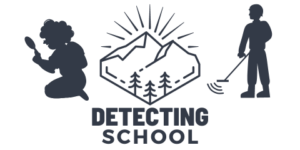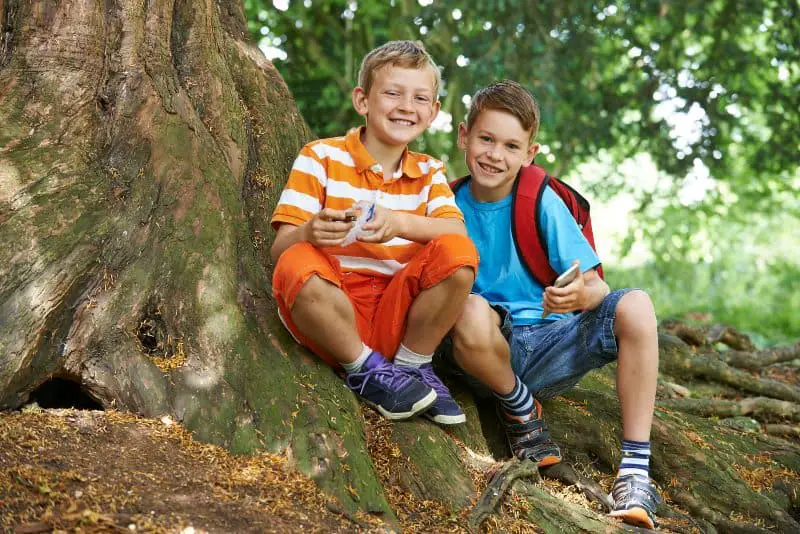
I have 2 kids and one of the hardest things to do is to find an interesting and safe activity to keep them busy!
Thankfully, Geocaching has proven to be a great activity for kids, not only because it an outdoor exercise, but also, because it pushes the kids to do effort to, hopefully, be able to find treasure AKA (geocaches) through research.
Go and ask any kid, they will tell you that treasure hunting is one of their favorite activities.
In this article, I walk you step by step through the right approach to help your kids learn this hobby and do well at it.
Why Geocaching is a great hobby for kids?
Geocaching is an amazing hobby for kids because it helps them explore the world around them and helps them develop their imagination!
Most parents would agree their child could use more time outdoors and away from a screen.
Geocaching gives them the opportunity to explore their own city, while getting up and off the couch.
The game itself is about exploration with a decent amount of creative thinking. It’s a real treasure hunt that makes them the treasure hunter. They have to think like a person who would hide treasure in order to find it.
They will have to think outside the box to discover new caches because other players are doing their best to hide them well.
How to get kids excited about the hobby?
First off, they must remember that Geocaching is a Fun activity. The object of the game is to find the treasure. You can play off this in any way you want that will keep your kids excited about the idea.
Whether you want to come at it as an Indiana Jones type of twist or a pirate looking for lost treasure, either idea incorporates a familiar character type to keep the game interesting.
A bit of roleplaying will keep kids interested. Especially if you show them a treasure hunting movie before heading out.
Another tip is to focus equally as much about where the cache is and not so much about the cache itself. You can help associate discovering new areas and fun things to do while you are there after finding a cache. This means a cache is a means to an end.
Tools your kid needs to bring …
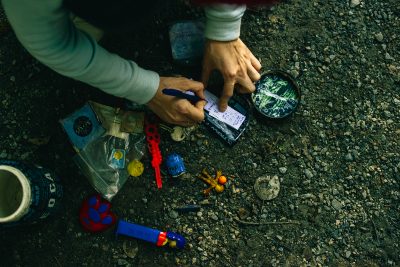
The tools you need for your kids will be the same as any other player. For example:
- Geocaching app
- GPS (Check this one here at Amazon)
- Pen
- Proper Clothing
- Water
Geocaching involves a ton of walking. Unlike adults, children may not have the muscle endurance to hunt for long periods of time.
Proper nutrition will definitely keep energy levels high enough.
An often overlooked piece of equipment is some type of identification. With adults, it’s a little more difficult to get lost.
However, a lost child is a tragedy and a major fear that some unfortunate parents have gone through.
In a blink of an eye a child could get out of sight.
In the rare chance a child goes missing, a form of identification will vastly improve the odds of that child being returned faster.
Helpful Tip: using a remote finder for kids is great way to keep tracks of kids while hunting. This wireless remote finder is a great example that you probably should check.
Looking for a cache – the proper way!
Let’s assume you have already made an account on the official Geocaching website and now you are ready to go look for a cache with your kids. Where do you even start?
First, you need to determine where you want to look.
The best advice for new players is to try to find a cache as close to home as possible. There’s no need in traveling far for a cache you may not find. It’s a bad experience when something like this happens.
Instead, try to find a cache close to your home. There’s little investment when going about it this way. Plus, if your child tires out quickly, at least you’ll be close to home.
Now that you know where to look, you will want to look for the easiest caches nearby. Stick to 1/1 level caches. These caches are easy to spot, and the terrain is accessible to people with disabilities. Finding an easy cache will keep your kids interested.
Wandering around aimlessly the first couple of caches will definitely make your kid lose interest in the hobby.
Choose a few caches for your first day out hunting. In the off chance you don’t find your first cache, you’ll want a couple of backups.
Something you should consider when looking for caches is whether they are located in places your child is familiar with.
It’s exciting for a child to find a cache in a place they visit often. It gives them a sense that a cache could be anywhere and everywhere they have ever been. Now, familiar places are new because they might be hiding something.
Aim for easy caches in places you both know. You’ll start off on a good foot starting the hobby this way.
What should the kid do once he finds a cache?
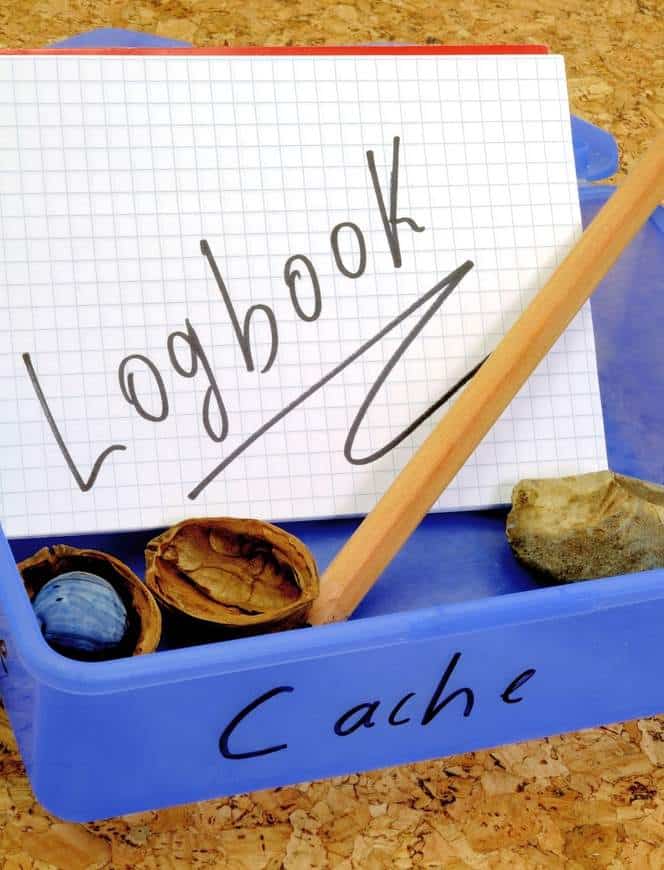
After you made a list of your chosen caches, next is to go find them. Let’s use a cache hidden in a park as an example. These types of caches are easier to find:
Open the official app, or any app of your choice, and make your way close to the cache. Here’s your opportunity to let your child explore. By nature, geocaching is a game of hot and cold. You could follow this same principle while hunting.
As you get closer to a caches location you can begin to let your child do all the searching. After all, it’s up to your child to find the cache. Simply telling them if they are hot or cold will help guide them right to the cache.
At this point, neither of you will know exactly where the cache is. You could do some forward thinking by reading the log of the cache. Someone may leave a hint as to where the cache is hidden. You’ll find out where the cache is, but ultimately your child will find it.
Have your child look everywhere – under benches, tree limbs, bushes.
Once they locate the cache have them sign the log. They’ll put their username and date. For this example, we are assuming you created the profile to log the cache with your child’s information.
If the cache is large enough to trade out an item with one of yours, now is the time to do that. Again, all the decisions are up to your child. Have them choose what they want to take and leave behind.
Ask them what they want to comment about the cache on the app. Was the cache easy to find? Was it easy to open? What kind of condition is the cache in?
Don’t forget to take a picture of your child with the cache before they put it back. It’s definitely worth taking a photo of their first find, and any others they find.
It’s important to log your find since it’s part of the game!
The comments left about the cache help the owner maintain the cache. You could let them know if something is wrong with the cache such as a missing log sheet.
Remember, log every find on the app!
Hiding the caches – Step-by-Step …
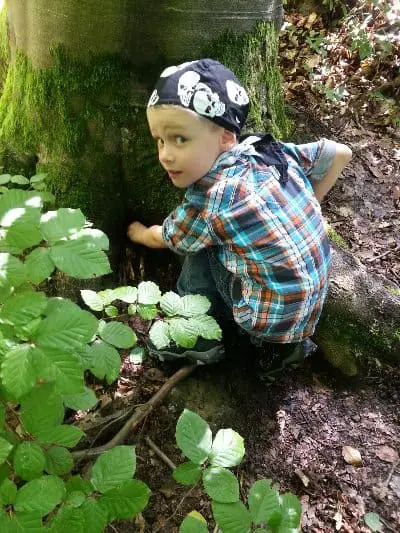
Hiding caches is equally fun as finding them. Just like finding caches, you’ll want to be a guide for your child when determining what and where to hide their cache.
First, you need to know that caches must be approved by geocaching reviewers. Their job is to ensure caches follow geocaching guidelines. Once they approve your cache, it goes live and players can locate your cache to log it.
The official site has tons of great information about types of caches you can hide and where to hide them.
You’ll want to follow these guidelines to avoid having a reviewer reject your cache.
My suggestion is to hide a large ammo can or large tupperware container. The reason is they have room to store items to be traded. Not is it going to be fun covering your container in camo, but it will also be fun determining what to put inside for trade.
Let your child load up the container with as much as they want for other players.
Once the cache is ready, find an ideal spot. You’ll want an area nearby since you will be upkeep the cache. Maintaining the cache is your responsibility and you won’t want to travel far to do so.
Let your child choose the perfect spot. A bush is a great candidate.
You’ll want to find an area that is easily accessible and one you’ll remember. Once a week you’ll want to have your child come and find what was traded and whether or not the cache needs any upkeep.
Maintaining a cache is a great way to teach responsibility to your child. Make them aware that the cache is their responsibility and it is up to them to ensure other players are able to locate it.
Once others begin to log your caches a couple of times, then you can move onto hiding another. Next time, you might want to choose a smaller cache to hide. Steer them to being more creative with their hiding spots.
Hiding caches brings a new element to the game and will definitely keep your child interested in the hobby.
Important Geocaching Techniques
Becoming a successful geocacher will take time. However, here are some important geocaching techniques that will help speed up the process.
First off, the log is your friend. What I mean by that is the log for caches you find on the app. Whenever a person finds a cache and logs it in sometimes they leave clues as to where they found it. Or, whether or not they found it.
These hints might come in the form of clever phrases such as, “good thing I kept my eyes on the ground.” In a roundabout way they gave away the cache will be found on the ground.
When you find a cache you have the opportunity to log a photo as well. Many players take the time to take a picture by where they found the cache. Use the photo as a way to narrow down where you should be looking.
Another important technique is to think like a geocacher. What this means is to imagine where you would hide a cache so muggles wouldn’t find it. Thinking like a geocacher will help with discovering more caches.
After a while, your kids will begin to know exactly where to look first. They will be able to scan an area and know all the best hiding places.
Important Safety Measures
Just like any other sport or hobby, geocaching carries its own dangers and risks. When dealing with the great outdoors, danger is always around the corner.
Here are some safety measures you can take to prevent danger or avoid any risks involving geocaching.
Obviously, you have told your children the dangers of talking to strangers. Well, if you have yet to have the talk, now is the time.
Even the most friendly looking may have the worst intentions. When wandering around the woods, city, or local park make sure you always have a watchful eye on your children.
Earlier, it was mentioned to have some type of identification on your child. It’s worth mentioning again here. In case you ever get separated from your child, at least there will be some way for another adult to get in contact with you.
On the topic of avoiding strangers, it’s worth noting wildlife falls in the same category. The dog you have back at home may be friendly, but that doesn’t mean the one you encounter at the park is too.
Teach your children that animals can change their demeanor in the blink of an eye. It’s best to avoid them if possible.
Also, keep aware of where you are looking for a cache. Bushes have sharp branches and I know another geocacher who poked their eye out while looking inside one. Never let your child stick their hand anywhere you are unsure of.
Finally, I highly invite you to learn about Geocaching safety measures!
Important Geocaching Ethics
The geocaching code of ethics is important for a number of reasons – safety, integrity, legality, and keeps the game available for players.
Let’s start with safety. Being safe is the most important part of geocaching. Without caution, a person could quickly find themselves in danger while out on a hunt. Teaching your kids all the different dangers that are out there will prepare them to hunt safely.
Kids for the most part are unaware of their surroundings. Until they grow older and learn to look around, you’ll have to be their eyes.
Integrity in the sense that being true to yourself is most important. Doing the right thing every time is the right thing to do. This means taking only one item to swap and not emptying out a cache – as tempting as it might be.
Legality is often overlooked when hunting in public places. In terms of geocaching, legality involves no trespassing. This all goes back to being aware of your surroundings. Know where you are at all times and you’ll be fine.
Kids are unaware of what trespassing means. As far as they are concerned, if they can see ground they can walk on it. Make sure they respect others’ property and everything will be fine.
The code of ethics is designed to keep everyone safe and the game accessible to everyone.
Important Geocaching Terms
Like any other hobby, there are terms unique to geocaching. Don’t worry, you won’t need to remember them immediately to “fit in.”
Here’s a few you should know to get you going. The more time you spend on the forums the more you’’ll pick up. These however are some you should share with your kids soon.
Muggle – A non geocacher. Yes, it’s based off Harry Potter.
Muggled – The discovery of a geocacher by a non geocacher. It’s a 50/50 chance they’ll leave a cache alone.
Ammo Can – Ammunition boxes or ammo cans that are containers for safely transporting ammo which have been repurposed for geocaches.
Attributes – These are the details about a cache. This includes difficulty, terrain, and other important information.
BYOP – “Bring your own Pen/Pencil” Sometimes caches are not large enough to hold a writing utensil. You should practice bringing your own at all times anyways.
DNF – Sometimes you don’t find a cache. It happens. You can still log the cache and write DNF to let yourself know to come back to it later.
FTF – The coveted FTF means first to find. This means you were the first to find the cache. Kind of a high honor.
Geocacher – This one is self-explanatory.
GPS – “Global Position System” This system is what makes geocaching possible.
LN – “Left Nothing” is a common term used by geocachers who only signed the logbook and did not trade anything.
SWAG – “Stuff We All Get” Trade items left in caches by other players.
TFTC – “Thanks For The Cache” An acronym written by geocachers in logbooks or online when logging cache finds. It’s best practice to follow this acronym with a few sentences regarding your find.
Final Thoughts …
I am not sure how successful I was in this article, but I really hope that I’ve encouraged you enough to try geocaching for your kids.
Chances are, they will find all this stuff really exciting and will thank you for introducing them for this activity.
So, don’t waste a minute, sign up for the official Geocaching app, and let’s go for a hunt with the kids!!
Finally, I Highly invite you to learn how to get started geocaching! Where I explain step-by-step what you need to do to be successful in this activity!
